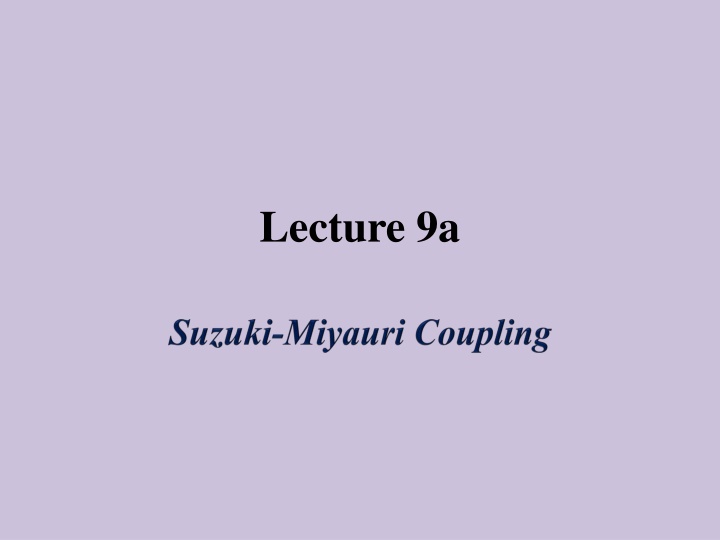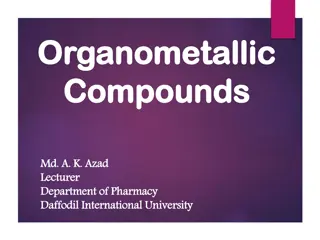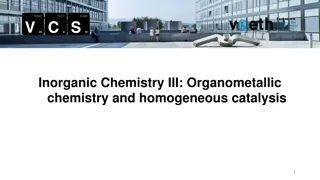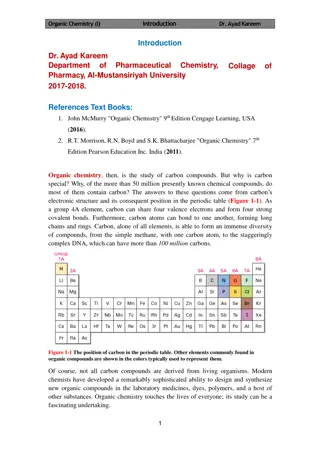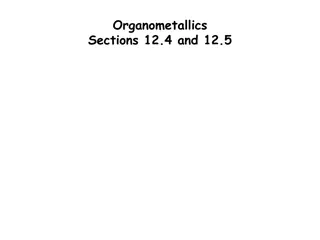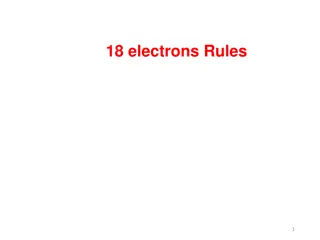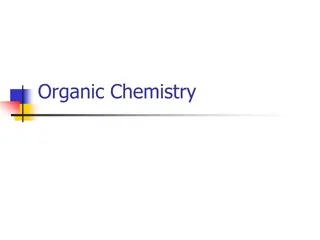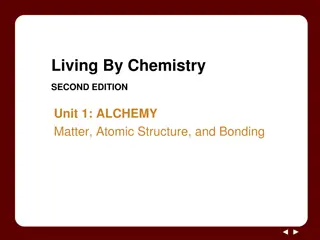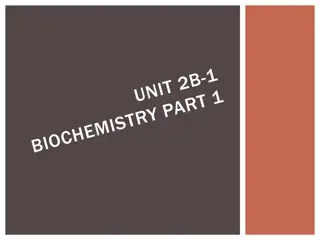Overview of Organometallic Compounds in Chemistry
Metalorganic and organometallic compounds play vital roles in organic chemistry, showcasing unique characteristics and diverse applications. From the pioneering discoveries of Cadet's fuming liquid to modern palladium-catalyzed reactions like Heck and Suzuki coupling, this field has continually evolved with significant contributions from researchers worldwide. Organocuprates, known as Gilman Reagents, are highlighted for their utility in performing substitution reactions. The emergence of novel bond models and catalytic reactions underscores the ongoing exploration and innovation within organometallic chemistry.
Uploaded on Sep 30, 2024 | 1 Views
Download Presentation

Please find below an Image/Link to download the presentation.
The content on the website is provided AS IS for your information and personal use only. It may not be sold, licensed, or shared on other websites without obtaining consent from the author.If you encounter any issues during the download, it is possible that the publisher has removed the file from their server.
You are allowed to download the files provided on this website for personal or commercial use, subject to the condition that they are used lawfully. All files are the property of their respective owners.
The content on the website is provided AS IS for your information and personal use only. It may not be sold, licensed, or shared on other websites without obtaining consent from the author.
E N D
Presentation Transcript
Introduction I Metalorganic compounds have carbon in the compound but no direct metal-carbon bond i.e., sodium acetate. Organometallic compounds have a direct metal-carbon bond i.e., methyl lithium (LiCH3), methylmagnesium bromide (CH3MgBr). Organometallic compounds are known for more than 250 years: Cadet s fuming liquid (~1760, (CH3)2As)2O) is the first organometallic compound described in the literature. Zeise s Salt (1827, Na[PtCl3(CH2=CH2)]) is used as starting material for cisplatin (cis-PtCl2(NH3)2). Nickel tetracarbonyl (1890, Ni(CO)4) is used to refine Ni-metal. Ferrocene (Fe(C5H5)2) that was discovered in 1951 by P. Pauson and S. A. Miller introduced a new bond model (sandwich complexes) for transition metal compounds. In 1968, R. Heck published a total of seven papers about palladium-based arylation and allylation. http://upload.wikimedia.org/wikipedia/commons/thumb/c/c7/Zeise%27s-salt-anion-from-xtal-3D-balls.png/200px-Zeise%27s-salt-anion-from-xtal-3D-balls.png
Introduction II In many organic compounds i.e., carbonyl compounds, organohalides, etc., the carbon atom possesses an electrophilic character: X + + + C O C M C X Organometallic compounds are largely covalent but the carbon atom has a different bond polarity compared to most organic compounds (Umpolung). In organometallic compounds the carbon atom has a higher electronegativity (EN: C=2.5) than the metal atom (EN<2.0), which makes the carbon atom nucleophilic. http://webassign.net/graphics/electronegativities.gif
Introduction III Organometallic compounds have been proven to be very good synthetic tools in organic chemistry. Organocuprates (Gilman Reagents) They are used to perform substitution reactions on or adjacent to sp2-carbon atoms. H Br + (CH3CH2)2CuLi H CH2CH3 THF + CH3CH2Cu + LiBr H3C CH3 H3C CH3 Br CH3 THF (CH3)2CuLi + + CH3Cu + LiBr O O They are very mild nucleophiles due to low bond polarity in the Cu-C bond (EN: Cu=1.9, C=2.5 EN= 0.6). They usually favor 1,4-additions on -unsaturated carbonyl compounds. Note that in most reactions only one R-group of the cuprate is transferred.
Introduction IV Palladium-catalyzed Reactions Heck Reaction, Stille Reaction, Suzuki Coupling, Negeshi Coupling (not shown below) Catalysts: Pd(PPh3)4, PdCl2, Pd(OAc)2, Pd2dba3 O O Pd(PPh3)4 + CH2=CH2 + HBr Heck reaction Et3N Br Br Pd(PPh3)4 + (n-Bu)3SnBr + CH2=CHSn(n-Bu)3 Stille reaction THF O O Pd(PPh3)4 Br + + HO-B B NaOH O O + NaBr Suzuki reaction
Suzuki Reaction I The Suzuki cross-coupling reaction was discovered in 1979 by Akira Suzuki, who shared the Noble Prize in Chemistry with Richard Heck ( 10-10-2015) and Ei-ichi Negeshi for their discovery of palladium- catalyzed cross coupling reactions in 2010. The reaction gained a lot interest because important starting materials and intermediates like polyolefins, styrenes and substituted biphenyls (i.e., NSAIDs like felbinac, diflunisal, fenbufen).
Suzuki Reaction II The reaction presents a mild way to form carbon-carbon -bond using a organoboron (i.e., boronic acid, boronic ester), an aryl or vinyl halide under basic conditions in the presence of Pd(0) that is either generated in-situ from PdCl2 or Pd(OAc)2, or added as Pd/C. This reaction is an example for a group of palladium-mediated coupling reactions that have been discovered over the past forty years.
Suzuki Reaction III Most recently, Dr. Garg s research group was able to carry some of these reaction out using nickel catalysts as well (i.e., NiCl2(PCy3)2). The reaction can also be expanded to the coupling of heteroaromatic systems (OMs=CH3SO3-).
Suzuki Reaction IV Mechanism Reductive elimination Oxidative addition Ligand exchange Transmetalation
Suzuki Reaction V Summary The reaction starts with the deprotonation of the phenol that leads to the formation of the phenolate ion The phenolate undergoes an oxidative addition with the Pd0 specie. After the iodide is replaced by the carbonate ion, the intermediate is reacted with the boronate ion. In the transmetalation step, the aryl group replaces the carbonate ion. The resulting specie reductively eliminates 4-phenylphenolate and recycles the Pd0 catalyst. After the addition of an acid (during the work-up), the neutral phenol is formed, which precipitates from solution.
Suzuki Reaction VI Other Considerations In most reactions, the oxidative addition step is the rate-determining step in the catalytic cycle. The palladium is coupled with aryl halide to yield and organopalladium complex. The ArX is the electrophile in this reaction. The reactivity decreases in the order I>Br>Cl>F>OTf. In the lab, the choice will usually be aryl iodides, which afford high yields under mild conditions due to their high reactivity resulting in relative short reaction times. In industrial production, substrates containing chlorides as leaving group are the more common because of the lower cost compared to iodides. Iodides and bromides tend to be less popular because the atom economy is significantly lower for these substrates due to the higher mass of the halide. In the transmetalation step, the ligands are transferred from one specie to another. In the case of the Suzuki coupling, the ligands are transferred from the organoboron species to the palladium(II) complex, where the base that was added in the prior step is exchanged with the R1 substituent on the organoboron species to give the new palladium(II) complex.
Green Chemistry Highlights Solvent: Water as reaction solvent Energy: Short reflux (~30 min) Catalyst: Pd/C (not cheap but can be recycled easily) Reagents: mixed bag in terms of hazards
Experiment I Phenylboronic acid, potassium carbonate and iodophenol are suspended in water. The palladium catalyst (Pd/C) is added. The mixture is vigorously refluxed for 30 minutes. What is the function of the potassium carbonate here? It acts as the base in the reaction to deprotonate the phenol What should the student observe at the end of the reflux period? A grey suspension Why is this necessary? The acid neutralizes the base allowing for the neutral phenol to form. Careful, because carbon dioxide will form. After cooling the mixture down, hydrochloric acid is added slowly. The precipitate is isolated by filtration. What does the solid consist of? The catalyst and 4-phenylphenol
Experiment II The solid is transferred into a beaker and a minimum amount of methanol (~5 mL) is added to dissolve the phenol. The catalyst is removed by filtration (use a clean filter flask here!). The mother liquor is transferred to a small Erlenmeyer flask and the same amount of water added. The mixture is reheated to dissolve the product that should precipitate upon cooling. Submit NMR sample (50 mg/mL CDCl3) and GC/MS (1-2 mg/mL ethyl acetate). Which observations are made here? The remaining solid usually decreases in mass and gets darker Where is the product at this point? The catalyst remains on the filter paper while the product is in solution. What does the addition of water do? It increases the polarity of the solution causing the low polarity compounds to precipitate
Characterization I Melting Point Infrared Spectrum (OH)=3200-3600 cm-1 (the exact peak appearance depends on the water content of the acid) (C-OH)=1251 cm-1 (shifted to higher wavenumber due to the high s-character in the C(sp2)-O bond) Out-of-plane bending modes at = 690, 758 (mono) and 836 (para) cm-1 (OH) (C-OH) oop
Characterization II 1H-NMR Spectrum (CDCl3) 11.5 11.0 C D 10.5 10.0 9.5 9.0 8.5 8.0 7.5 B 7.0 6.5 E 6.0 5.5 5.0 4.5 4.0 3.5 A 3.0 2.5 2.0 1.5 OH 1.0 0.5 0.0 7.5 7.0 6.5 6.0 5.5 5.0
Characterization III 13C-NMR Spectrum (CDCl3) 120 A/C 115 110 105 126.70 100 95 90 85 G 80 75 128.40 128.70 115.70 70 65 60 B F 55 50 45 40 35 30 25 H D E 20 15 155.50 140.90 133.80 10 5 0 155 150 145 140 135 130 125 120 115
Characterization IV Mass Spectrum m/z=170 (100 %) m/z=141 (16.2 %) m/z=115 (11.2 %) m/z=171 (13.4 %)
